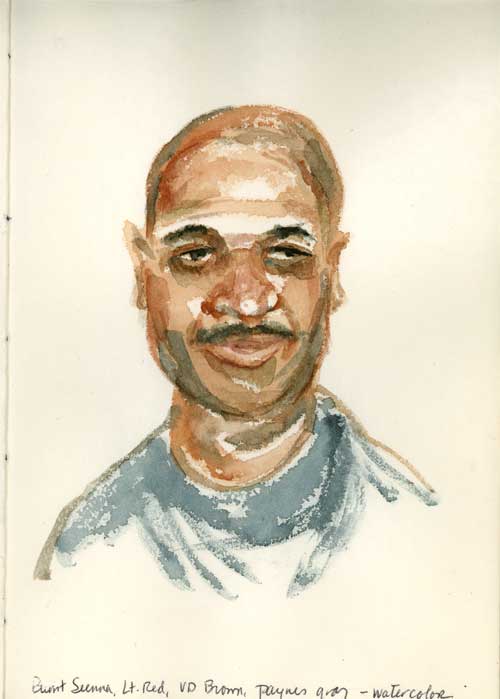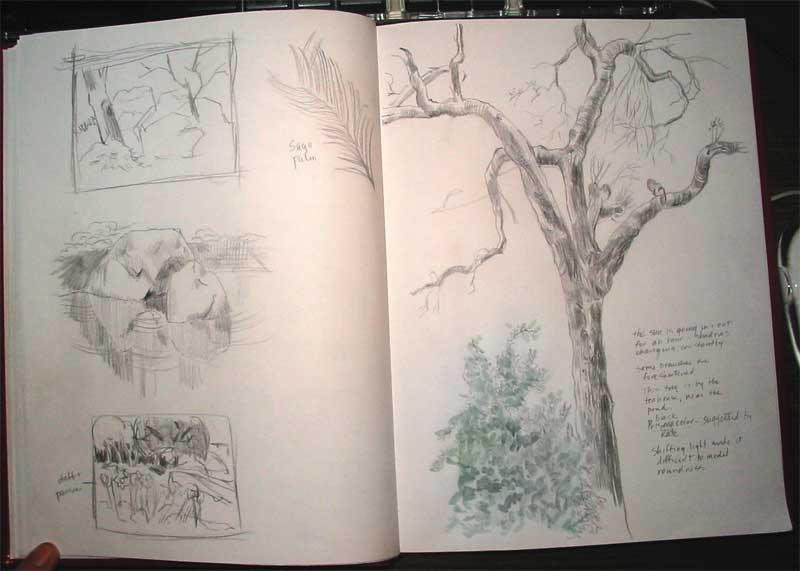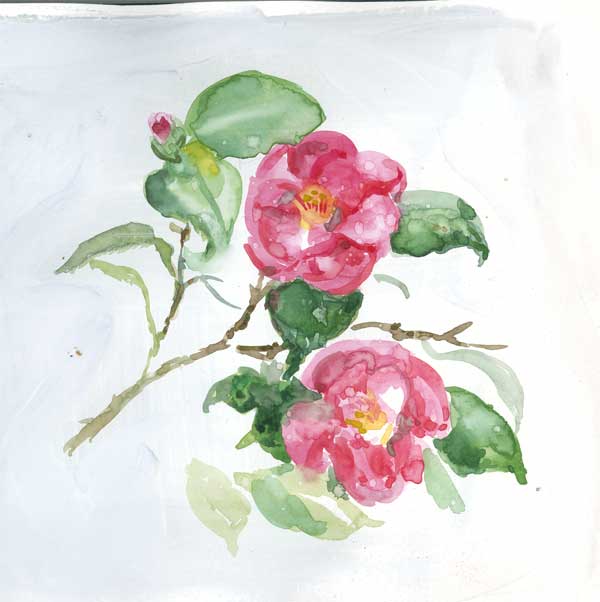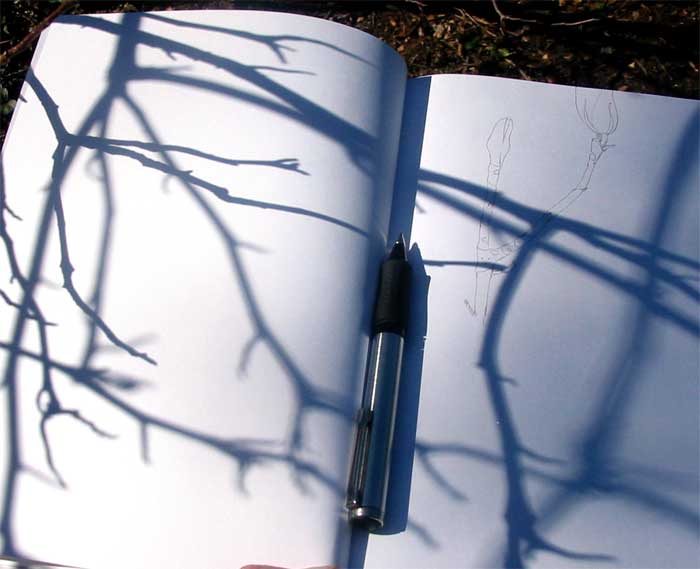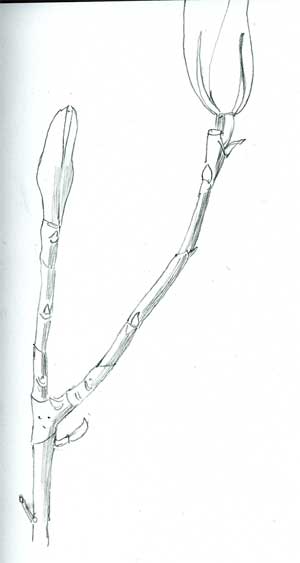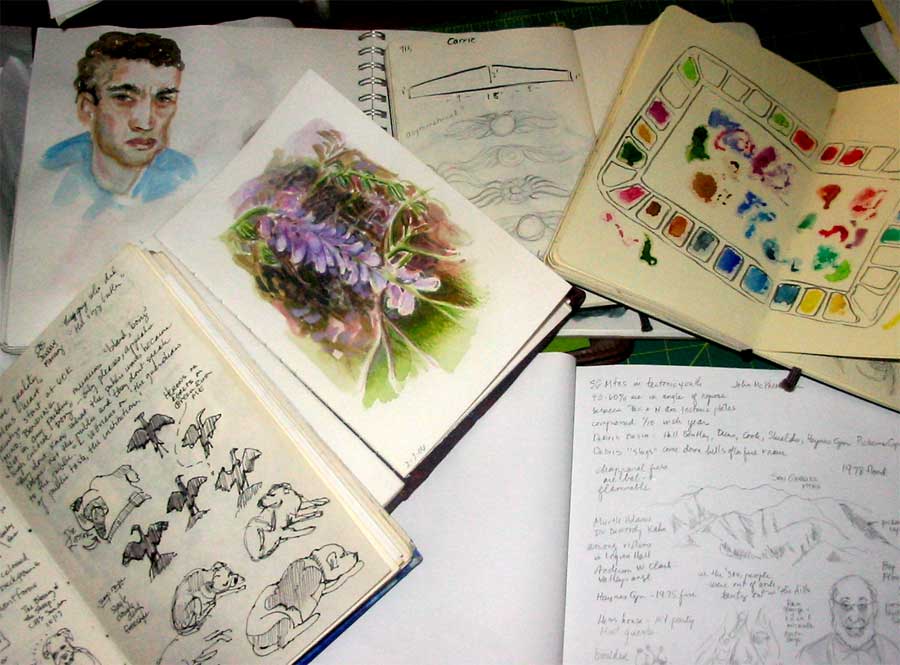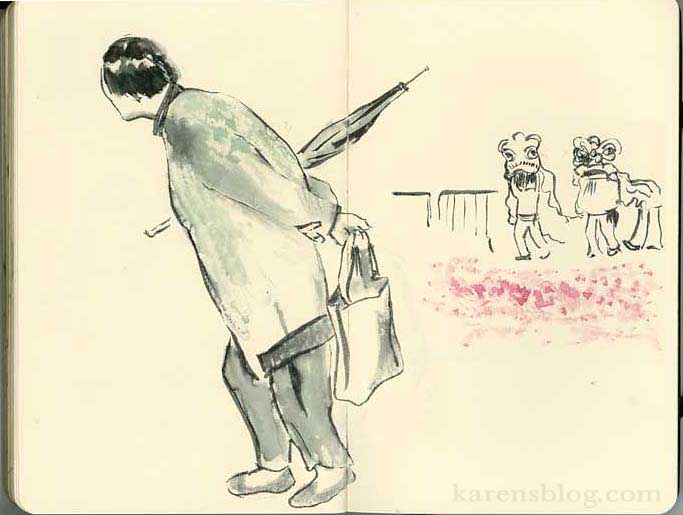Teahouse of the February Morning – TEA for Illo Friday
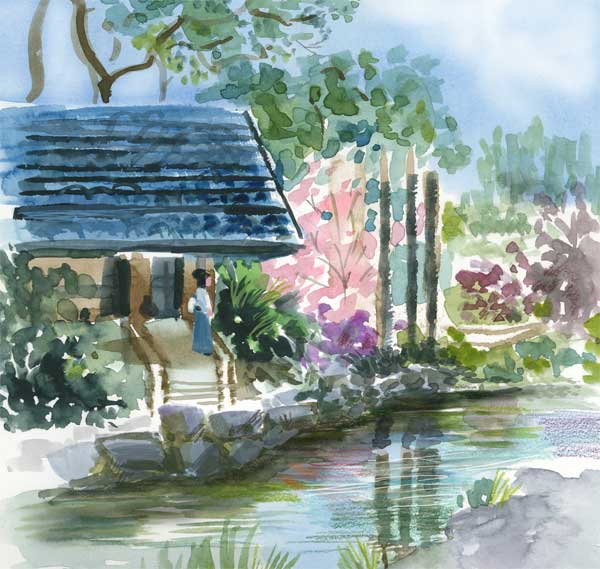
A watercolor sketch of the teahouse at Descanso Gardens. Kind of. Sort of. I took a lot of liberties with it, as I understand a painter has a right, maybe even an obligation to do.
I might make a painting of this someday. For now, it’s just a study for practice. Did you know that a pivotal scene from Memoirs of a Geisha was filmed here? I didn’t – until a few days ago. Can you spot the koi in the water?
I am also going to call this my first “local landmark” for the Everyday Matters “draw a local landmark” challenge. I have a few others I think I will do also.
Arty notes: 9 x 9 Super Deluxe Aquabee sketchbook, watercolor and some colored pencil for enhancement.
portrait for practice
A quickie watercolor sketch portrait in the old “blue coptic” journal , done from photo ref, which I made a few years ago. The paper is awful – coarse, too absorbent, and you can’t push paint around when you apply it; it sinks in immediately. But I’m too stubborn to just put it away with a dozen or so pages left unused. So I’m going to use it up in the next few days so I can be DONE with it, already. The one “good” thing about this paper, if you can call it that, is that it forces you to be as deliberate with your brushstrokes as drawing with a pen. There’s no “lifting” the watercolor – it’s as merciless as indelible ink.
Why the bad paper? Because I had it on hand – some old drawing paper torn out from a tablet – and I didn’t expect the book to turn out well and didn’t want to waste “the good stuff.” And then I was stuck with it. Oh, and it kind of beads up, too, before it sinks in.
Hmmm … what about acrylic gesso on the page first … I’m going to experiment.
Now, Kate is much more optimistic and practical than I – she used good paper for her first journal, which she posted today on her blog. You should see it, it’s really nice.
Another sketchcrawl page
My workbook is evolving, and so am I. Sometimes the mood strikes me to do compositional and value sketches; other times I might be captivated by the texture of a rock, carefully observing the nature of reflections. On Saturday, while hiding out from the sprinkling of rain under the teahouse roof, I settled in to do a long, slow drawing of a California Live Oak. The biggest challenge was trying to describe the volume of the limbs when the light kept changing (like the camellia painting I posted two days ago.) Still, it was a satisfying sketching session and I felt like I got to know this tree a little better.
Too big to fit under my scanner, this 9 x 12 Watson Guptill sketchbook is a good size for trees and big objects.
Camellias Sketchcrawl style
Saturday, four hardy artists braved the cold temperatures and sallied forth to Descanso Gardens for a sketchcrawl. Because it was sprinkling, our first stop was the Japanese teahouse with its sheltering roof, which protected us from the morning drizzle. We sketched there for an hour or more and then, seeing that the sun was peeking occasionally through the clouds, we ventured out into another part of the garden.
I stopped at a camellia bush where I painted this cluster for a little while. I used a page in my Canson watercolor journal that I had previously started at the Chinatown parade, then rapidly gave up on. (Digression warning) The only scribble on said page was a stiltwalker in drag wearing a slinky Chinese dress. Think “Al” from ToolTime (the flannel-shirted, bearded one) wearing a dress from The World of Suzie Wong, only imagine him 10 feet tall. Got the picture? There simply wasn’t time to capture him/her in all his/her glory, so I gave up somewhere between the mandarin collar and the flash of beefy thigh. However, being of a frugal nature, I painted over the page with a few coats of Liquitex acryllic gesso (white) figuring I’d do something else in that space.
The else moment arrived on Saturday. I painted these using my portable w/c palette (which I have since misplaced, unfortunately.) The first challenge was trying to figure out the values of the colors when the light conditions went from full sun to dark stormy clouds, minute by minute. The next challenge was painting directly without doing any drawing or sketching underneath. Usually shadows provide positive and negative spaces to get ones bearings with. But everytime the sun went away the image “flattened out” and the shadows disappeared.
The final challenge involved the medium itself. The watercolor flowed smoothly over the gessoed surface and was surprisingly malleable until it dried. I’m guessing that the gesso prevented it from sinking into the paper, so the pigment was simply a dry layer on the surface. When raindrops started falling, it created dissolved water drop marks. Before I panicked, I realized that it looked somewhat like raindrops clinging to the petals. Hmmm. An accident becomes a technique. “Why yes, um, er, I did plan it exactly that way, timing my painting so the waterdrops would fall just so at the appropriate moment.” Sorry, Karen, not very convincing. At any rate, I stopped painting before the droplets turned the whole thing into a runny splotchy mess.
I had a nice moment when some camellia watchers came by and asked if they could see what I was doing, which I happily shared with them.
So that’s my sketchcrawl story. I am now in pursuit of the missing palette which I surmise may be proof positive of poltergeist activity in my house. When I find it, I suspect a lost shaker of salt will be nearby. Wasted away again in Watercolorville.
Sketches are made by fools like me
It’s startling to me at times how I can get so caught up in what I’m doing and ignore the obvious.
Today I spent some time at Descanso Gardens with my husband, enjoying the beauty of a spring (Valentine’s) day, and I took my time doing a very detailed line drawing of a magnolia twig. As I peered at it intently, something “clicked” and I realized one of the purposes of botanical drawing. When you observe something very closely – and I mean down to the 1/16 of an inch closely, you start to understand what the plant does. You begin to sense which way the twig will bend even before it does. You know where the leaf will come out of an axil, and what side it will be on. You begin to think, perhaps a little bit, like a plant. OK, that’s too new age, scratch that. You know what I mean. You begin to understand the plant intimately, becoming lost in its anatomy, its function and its beauty.
So, as I was fixated on this small twig, working slowly and methodically, I lost sight of the larger plant patterns that shared the same white space: the bare winter bones of the magnolia overhead, the tumescent buds, the rhythm of line and shape, the lost and found edges, the positive and negative spaces. While I was trying to capture nature with my pencil, Nature was impishy doing her own dance with effortless grace, as though to taunt me. But perhaps to lead me on, to keep practicing and to keep looking. I bow to you, Madame Magnolia. You win. Sketches are made by fools like me, but only God can use light to paint a tree.
My artworkbooks
As you can see, I use my journals for a lot of different purposes, not only for sketching pleasure. As I’ve committed myself to doing more painting this year, I find that I’m reaching for it more and more as a practical workbook, not a chronological diary of my days. In fact, I have numerous workbooks with different paper in different sizes. I keep notes of ideas for paintings, I try out color mixtures. I paste in swatches of different kinds of paper and practice different drawing techniques. I work out designs for soft block carving. I carry it with me to museums and make notes about the artists. I even print out and paste in my sketches and paintings done in Photoshop or Painter.
This is my portable personal encyclopedia free of rules and concern about outcomes. The disastrous pages are as valuable as the “good” ones but none of them gets torn out and thrown away. It’s not an artists book destined to look pretty on its own. It’s a workbook – raw, spontaneous and full of scribbles and wrong turns. It’s where I map my “Creative Journey.”
Do you keep an art workbook for experiments and testing paint and such? Write and tell me about it.
karen@karenwinters.com
Chinese New Year 2006 – Part 2
Lions dance through fields of firecracker debris. Surely good fortune will follow.
Brush pen in my Moleskine … memories of the Chinese New Year parade.
